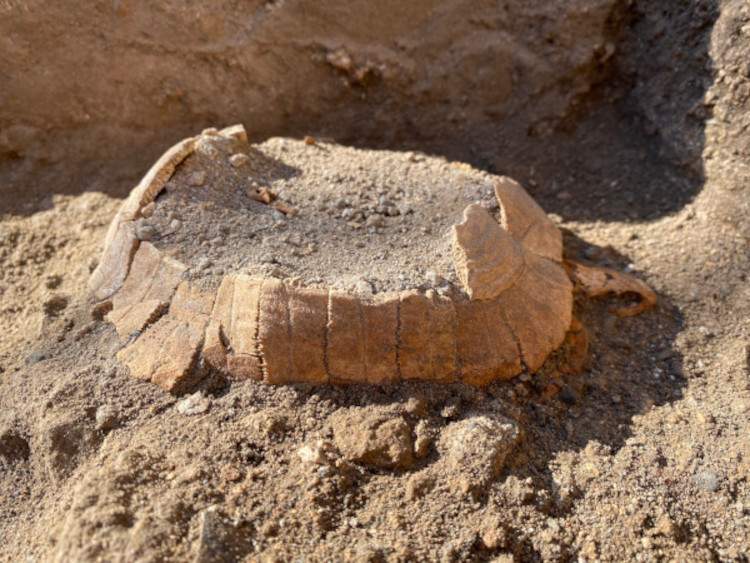Pompeii, remains of a turtle found with an egg in its carapace
The remains of a tortoise and its egg in the carapace were found in a workshop on Via dell’Abbondanza in Pompeii Archaeological Park. The discovery came as part of an excavation and research campaign on the Stabian baths, conducted by the Freie Universität Berlin and theUniversity of Naples L’Orientale, with theUniversity of Oxford in collaboration with the Pompeii Archaeological Park, aimed at investigating the urban development of the residential neighborhood before the baths were established.
“The ongoing excavation campaign in Pompeii,” said Culture Minister Dario Franceschini, “continues to reserve important finds and new discoveries, confirming the extraordinary richness of this authentic treasure chest of history and memory that fascinates the whole world.”
From the excavation, among the accumulations of detritus that formed following the decommissioning of the workshop in question, with a view to its re-functionalization, this small reptile appeared. In the reconstruction and renovation phase between the violent earthquake of 62 A.D. and the eruption of 79 A.D., the reptile had been able to enter the decommissioned spaces and burrow, undisturbed, into shelter.
This is not the first discovery of tortoises in Pompeii, but they have usually been found within gardens or areas inside rich domus, such as the house of Julius Polybius.
The tortoise was documented and removed in three successive stages: documentation of the carapace (about 14 centimeters, while a fully mature specimen usually measures 20-24 cm), the animal’s internal skeleton and the platron (i.e., the ventral part of the shell). The specimen was transferred to the Park’s Applied Research Laboratory where it will be studied and analyzed by the Park’s archaeozoologist. The specimen of Testudo hermanni, a local, female species, had probably taken refuge in the decommissioned space to find a suitable place to lay her only egg. Tortoises have a peculiarity, dystocia, meaning that if they do not find a suitable place, they can retain their eggs, encountering often fatal problems. They therefore prefer to die, rather than lay eggs where the environment is not congenial.
“Both the presence of the tortoise in the city and the abandonment of the sumptuous domus giving way to a new sector of the Stabian baths illustrate the extent of the transformations after the 62 A.D. earthquake,” said Pompeii Archaeological Park director Gabriel Zuchtriegel. “Evidently not all the houses were rebuilt and areas, even central areas, of the city were sparsely frequented to the extent that they became the habitat of wild animals; at the same time, the expansion of the baths is a testament to the great confidence with which Pompeii restarted after the earthquake, only to be crushed in a single day in AD 79. The tortoise adds a piece to this mosaic of relationships between culture and nature, community and environment that represent the history of ancient Pompeii. In the coming years, the study of organic finds and research on agriculture, economy and demography in Pompeii and its territory will be a priority in our strategy of research, protection and enhancement, also to give more visibility to sites and monuments outside the urban center, such as the villa rustica of Boscoreale and the villas of Torre Annunziata and Castellammare di Stabia.”
The excavation conducted by the international team of the three universities, an excavation that is also didactic aimed at training new generations of young archaeologists, investigated west of the entrance to the baths on Via dell’Abbondanza, the workshops at Nos. 6 and 7, characterized by a facade of Nocera tufa blocks. Store 6, the site of the find, was attached in its earliest phases to the baths via a door on the northern wall, which was closed at a later date. In the southwest corner of the workshop, a quadrangular basin uncovered with cocciopesto had been built in a phase before the earthquake of 62 AD. Right next to the basin, on the outer side, in the corner between the northern wall of the basin and the western wall of the workshop, a tortoise was identified that had made its burrow after digging a small tunnel that must have started from the post-seismic floor reaching a protected area.
 |
| Pompeii, remains of a turtle found with an egg in its carapace |
Warning: the translation into English of the original Italian article was created using automatic tools. We undertake to review all articles, but we do not guarantee the total absence of inaccuracies in the translation due to the program. You can find the original by clicking on the ITA button. If you find any mistake,please contact us.





























